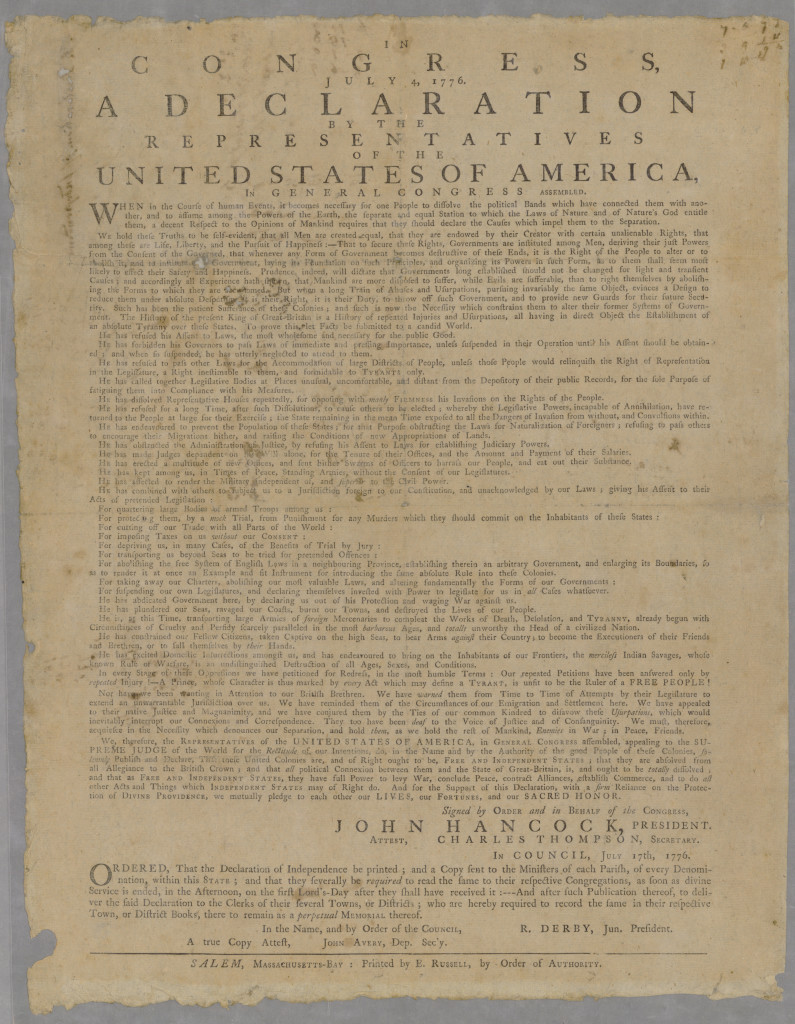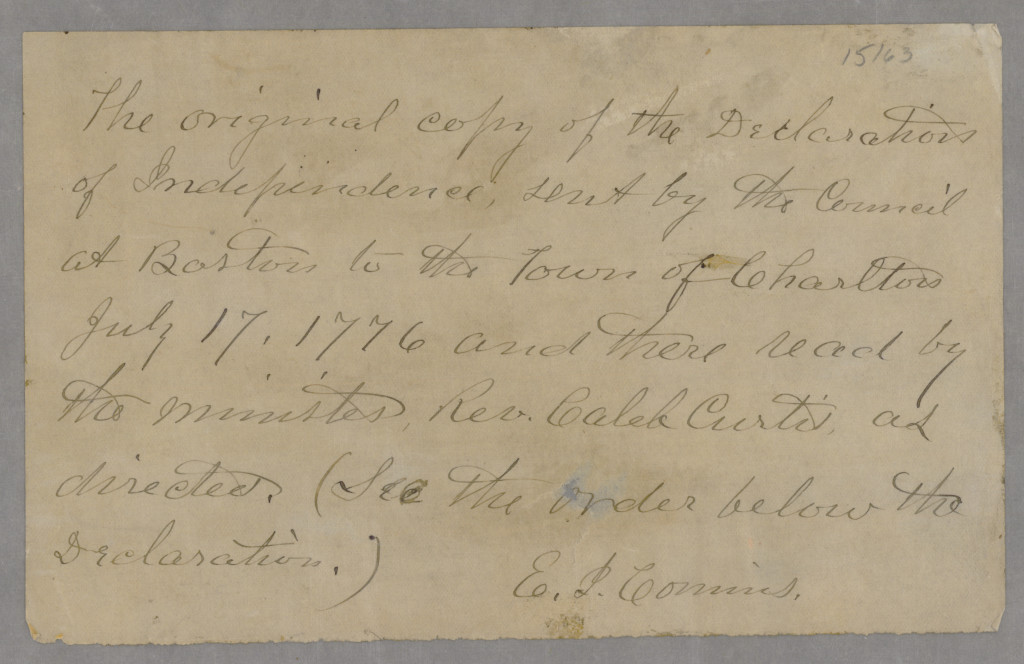As the United States is gearing up to celebrate its independence for the 239th time, here in the Outreach Department at AAS we’re also gearing up for another kind of event, taking place for the first time: hosting an NEH Institute for K-12 Teachers.
Among the many sessions in this institute, titled The News Media and the Making of America, 1730-1865, is one exploring the dissemination of the Declaration of Independence throughout the colonies in the days after July 4, 1776. Despite our current visual associations with the Declaration in its calligraphic form, complete with the proverbial “John Hancock,” the first copies of the Declaration shared with the public circulated in printed form. (In fact, the calligraphic version of the Declaration wasn’t even finished and presented for signing until almost a month later.) The first printing of the Declaration, done by John Dunlap, printer to Congress, was set in type immediately after its approval by Congress and printed overnight. From there copies were dispatched to each of the colonies, making their way through cities and towns, spreading the news along the way.
These broadsides worked in two ways. For one, they could be read aloud to gathered crowds, instantly and exponentially expanding their reach. In one such instance, AAS founder Isaiah Thomas waylaid a post rider on route to Boston with a copy of the Declaration and publicly read it to a  crowd in Worcester – the first public reading of the Declaration in New England – before giving it back to the rider and sending him on. Secondly, they also acted as copy for printers throughout the colonies, who immediately started cranking out their own broadsides and reprinting the text of the Declaration in newspapers. Both forms of communication – oral and print – were necessary and effective ways of spreading the momentous news.[1]
crowd in Worcester – the first public reading of the Declaration in New England – before giving it back to the rider and sending him on. Secondly, they also acted as copy for printers throughout the colonies, who immediately started cranking out their own broadsides and reprinting the text of the Declaration in newspapers. Both forms of communication – oral and print – were necessary and effective ways of spreading the momentous news.[1]
Proof of the ways in which printed and oral dissemination of the Declaration were intertwined in these early days can be found in a unique document in AAS’s collections (see right). At first glance this broadside edition of the Declaration, printed in Salem, Massachusetts, less than two weeks after the Declaration’s approval, doesn’t look much different from the Dunlap or other contemporary versions. But a closer look reveals an added paragraph at the bottom beneath the “signatures” of Hancock and secretary of the Continental Congress, Charles Thompson (see below). This section reveals that the Revolutionary Council of the State of Massachusetts ordered this broadside printed and a copy sent “to the Ministers of each Parish, of every Denomination, within this State,” so that they could read the Declaration to each of their respective congregations. After doing so, they were to deliver their copies to the “Clerks of their several Towns or Districts,” who were “required to record the same in their respective Town, or District Books, there to remain as a perpetual Memorial thereof.”
Here we have the governing body of Massachusetts – now given a new layer of authority with the approval of the Declaration – not only ordering more copies of the Declaration to be printed, but also prescribing ways in which it would reach the largest numbers of the populace. With the vast majority of citizens attending church services, this was in many ways a surefire way to get the most bang for their buck.
But, as scholars of reader response and print networks will tell you, it’s one thing to know something was distributed in such a way, but an entirely other thing to know if it was actually read as intended. What this particular document in our collections tells us is that, at least in one case, the local minister followed the order to the letter. Accompanying this broadside is a small scrap of paper with a handwritten note that reads, “The original copy of the Declaration of Independence, sent by the Council at Boston to the Town of Charlton July 17, 1776 and there read by the minister, Rev. Caleb Curtis, as directed. (See the order below the Declaration.) E. I. Comins.” How’s that for a historical smoking gun?
The Reverend Caleb Curtis was a member of what Peter Oliver, the last chief justice of the province under Royal rule and the author of “The Origin and Progress of the American Rebellion,” referred to as the “black regiment.” So called because of their black ministerial robes, the black regiment were ministers who advocated resistance and eventually independence from Great Britain. Curtis, the town’s first minister, was active in local politics and a staunch Whig. He served as a member of Charlton’s Committee of Correspondence and was present at a statewide convention of the Committees of Correspondences held in Worcester on August 9, 1774. Curtis also preached before the Charlton Militia, providing a blessing to them as they headed off to fight the Regulars at Lexington and Concord on April 19, 1775. One can easily imagine such a firebrand minister eagerly reading the Declaration of Independence before his congregation at the first opportunity.
So this Fourth of July, as our social media feeds fill with celebrations, well-wishes, and news articles about the holiday’s history, we’ll also be taking a moment to think about that first Independence Day(s), and how the colonial news and social networks, though not as quick as a click of a button, were no less interdependent, effective, and resourceful.
[1] For a full description of the early dissemination of the Declaration of Independence see Thomas Starr, “Separated at Birth: Text and Context of the Declaration of Independence,” Proceedings of the American Antiquarian Society, 110 (April 2000).


